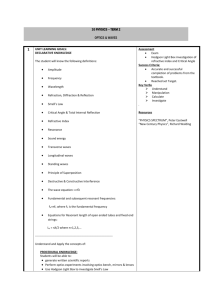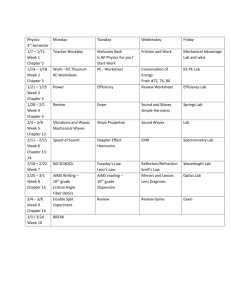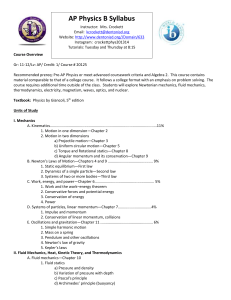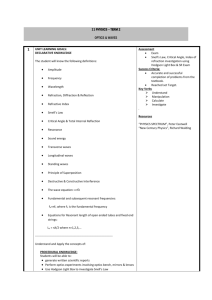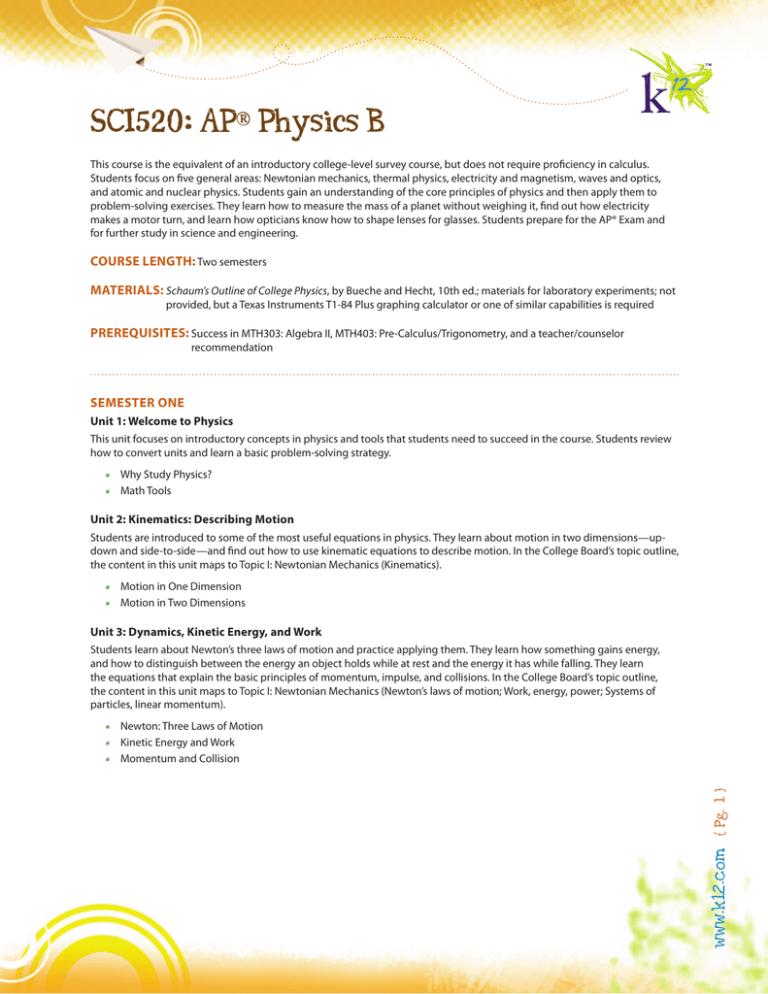
SCI520: AP® Physics B
This course is the equivalent of an introductory college-level survey course, but does not require proficiency in calculus.
Students focus on five general areas: Newtonian mechanics, thermal physics, electricity and magnetism, waves and optics,
and atomic and nuclear physics. Students gain an understanding of the core principles of physics and then apply them to
problem-solving exercises. They learn how to measure the mass of a planet without weighing it, find out how electricity
makes a motor turn, and learn how opticians know how to shape lenses for glasses. Students prepare for the AP® Exam and
for further study in science and engineering.
Course length: Two semesters
Materials: Schaum’s Outline of College Physics, by Bueche and Hecht, 10th ed.; materials for laboratory experiments; not
provided, but a Texas Instruments T1-84 Plus graphing calculator or one of similar capabilities is required
Prerequisites: Success in MTH303: Algebra II, MTH403: Pre-Calculus/Trigonometry, and a teacher/counselor
recommendation
Semester One
Unit 1: Welcome to Physics
This unit focuses on introductory concepts in physics and tools that students need to succeed in the course. Students review
how to convert units and learn a basic problem-solving strategy.
• Why Study Physics?
• Math Tools
Unit 2: Kinematics: Describing Motion
Students are introduced to some of the most useful equations in physics. They learn about motion in two dimensions—updown and side-to-side—and find out how to use kinematic equations to describe motion. In the College Board’s topic outline,
the content in this unit maps to Topic I: Newtonian Mechanics (Kinematics).
• Motion in One Dimension
• Motion in Two Dimensions
Unit 3: Dynamics, Kinetic Energy, and Work
• Newton: Three Laws of Motion
• Kinetic Energy and Work
• Momentum and Collision
www.k12.com
{ Pg. 1 }
Students learn about Newton’s three laws of motion and practice applying them. They learn how something gains energy,
and how to distinguish between the energy an object holds while at rest and the energy it has while falling. They learn
the equations that explain the basic principles of momentum, impulse, and collisions. In the College Board’s topic outline,
the content in this unit maps to Topic I: Newtonian Mechanics (Newton’s laws of motion; Work, energy, power; Systems of
particles, linear momentum).
Unit 4: Circular Motion, Gravitation, and Rotation
Students learn about circular motion, opening the door to understanding astronomy, cosmology, and the process of putting a
vehicle like the Space Shuttle into space and returning it safely to Earth. They learn about rotational equilibrium and torque and
how fluids shape our lives. In the College Board’s topic outline, the content in this unit maps to Topic I: Newtonian Mechanics
(Circular motion and rotation; Oscillations and gravitation) and Topic II: Fluid Mechanics and Thermal Physics (Fluid mechanics).
• Circular Motion
• Gravitation and Planetary Orbits
• Rotational Statics
• Fluids
Unit 5: Vibration, Waves, and Sound
Students learn about the motion of a pendulum, called simple harmonic motion (SHM). They learn about the properties of
waves, the characteristics all waves have in common, and how to distinguish one type of wave from another. They learn how
to measure and compare the intensity of sounds. In the College Board’s topic outline, the content in this unit maps to Topic IV:
Waves and Optics (Wave motion).
• Oscillation (Vibration) and Simple Harmonic Motion
• Waves
• Sound
Unit 6: Temperature, Heat, and Thermodynamics
Students learn about temperature, energy transfer, and thermodynamics—the study of how thermal energy can be converted
to mechanical energy and do work. They discover that no matter how efficiently a thermodynamic machine operates, it will
always contribute to the disorder, or entropy, of the universe. In the College Board’s topic outline, the content in this unit maps
to Topic II: Fluid Mechanics and Thermal Physics (Temperature and heat; Kinetic theory and thermodynamics).
• Temperature, the Ideal Gas Law, and Kinetic Theory
• Heat and Phases of Matter
• Thermodynamics
Unit 7: Review and Exam
Students review what they have learned and take the semester exam.
• Review
• Exam
Semester Two
Unit 1: Electrostatics
• Coulomb: Law of Electrostatic Forces
• Electric Fields and Potential
• Capacitance
www.k12.com
{ Pg. 2 }
Students explore electric energy and learn about the basics of electric fields and potential. They learn about capacitance,
how capacitors hold charge, and how much energy a capacitor can store. In the College Board’s topic outline, the content in
this unit maps to Topic III: Electricity and Magnetism (Electrostatics; Conductors, capacitors, and dielectrics).
Unit 2: Electric Current
Students learn about direct current, how resistors operate in different types of electrical circuits, how electrical outlets work,
and why circuit breakers are important. They look at some real-life applications of capacitors in circuits and the relationship
between resistors and capacitors. In the College Board’s topic outline, the content in this unit maps to Topic III: Electricity and
Magnetism (Electric circuits).
• Ohm: Law of Electric Current and Resistance
• Introduction to Circuits and Circuits With Resistors
• Circuits with Capacitors
• Kirchoff: Circuit Rules
Unit 3: Magnetostatics
Students explore the relationship between magnetic fields and electric charges, and consider some typical magnetic
fields. They identify the basics of how electric current can create magnetic fields, analyze some of the common uses of this
electromagnetic phenomenon, and study the equations that deal with the electromagnetic relationship. In the College
Board’s topic outline, the content in this unit maps to Topic III: Electricity and Magnetism (Magnetostatics; Electromagnetism).
• Introduction to Magnetic Fields
• Applied Magnetic Fields
• Electromagnetic Induction
Unit 4: Electromagnetic Waves and Light
Students learn that radio waves, microwaves, ultraviolet waves, visible light, and even x-rays all are basically a form of
electromagnetic radiation. They learn about mirrors, reflection of light, and refraction (bending) of light, and its application
in fiber optics. They learn about common vision problems and how corrective lenses fix them. In the College Board’s topic
outline, the content in this unit maps to Topic IV: Waves and Optics (Geometric optics).
• Introduction to EM Waves and Light
• Mirrors
• Lenses
• Optical Instruments
Unit 5: Physical Optics: Interference and Diffraction
• Interference
• Diffraction
www.k12.com
{ Pg. 3 }
Students review their understanding of wave interference and extend that concept to light and color. Interference patterns
of light waves are caused by diffraction. Diffraction occurs when light bends or spreads around the edges of slits or other
obstacles. Students learn various ways to accomplish diffraction and the consequences. In the College Board’s topic outline,
the content in this unit maps to Topic IV; Waves and Optics (Physical optics).
Unit 6: Quantum Theory and Nuclear Physics
Students see how the worlds of chemistry and physics merge in the Periodic Table—the arrangement of elements in the table
and the electron configurations are all described by the energy levels proposed by the quantum model of the atom. They
learn about nuclear reactions: fission, the splitting of the atom, and fusion, the combining of two atoms of hydrogen to form
one atom of helium. In the College Board’s topic outline, the content in this unit maps to Topic V: Atomic and Nuclear Physics
(Atomic physics and quantum effects; Nuclear physics).
• Relativity and the Origins of Quantum Theory
• Atomic Structure: The Bohr Model
• Applied Nuclear Physics: Fission and Fusion
Unit 7: Review and Exam
Students review what they have learned and take the final exam.
• Review
• Exam
Copyright © 2008 K12 Inc. All rights reserved. K12® is a registered trademark and the K¹² logo, xPotential and Unleash the xPotential are trademarks of K12 Inc.
www.k12.com
{ Pg. 4 }


